Accounting Fundamentals Homework: Breakeven Analysis and Profitability
VerifiedAdded on 2023/01/06
|7
|1040
|73
Homework Assignment
AI Summary
This document presents a comprehensive solution to an accounting fundamentals assignment. It begins with a detailed calculation of the breakeven point in units and amount, followed by a profit analysis based on given sales and cost figures. The solution includes a 'new profit figure' scenario, incorporating a strategic advertising plan, and a discussion of the limitations of breakeven analysis, such as difficulties in cost differentiation, complexities with semi-variable costs, and complicated calculations. The assignment then delves into the significance of management accounting, explaining its role in business decision-making and its impact on improving profitability. It concludes by outlining key techniques of management accounting, including margin analysis, trend analysis, capital budgeting, and inventory valuation, providing a well-rounded overview of the subject matter.

Accounting Fundamentals
Paraphrase This Document
Need a fresh take? Get an instant paraphrase of this document with our AI Paraphraser
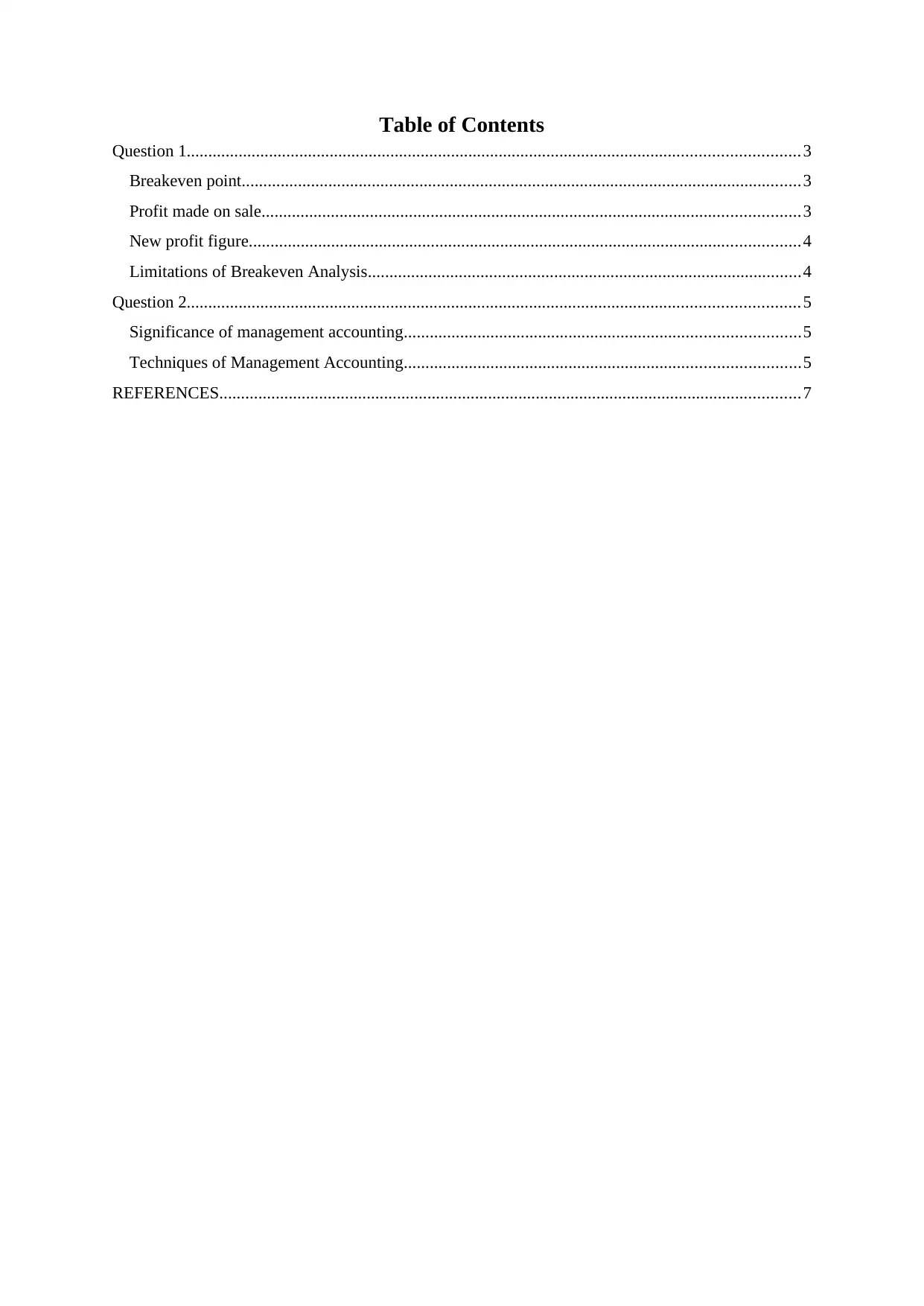
Table of Contents
Question 1.............................................................................................................................................3
Breakeven point.................................................................................................................................3
Profit made on sale............................................................................................................................3
New profit figure...............................................................................................................................4
Limitations of Breakeven Analysis....................................................................................................4
Question 2.............................................................................................................................................5
Significance of management accounting...........................................................................................5
Techniques of Management Accounting...........................................................................................5
REFERENCES......................................................................................................................................7
Question 1.............................................................................................................................................3
Breakeven point.................................................................................................................................3
Profit made on sale............................................................................................................................3
New profit figure...............................................................................................................................4
Limitations of Breakeven Analysis....................................................................................................4
Question 2.............................................................................................................................................5
Significance of management accounting...........................................................................................5
Techniques of Management Accounting...........................................................................................5
REFERENCES......................................................................................................................................7
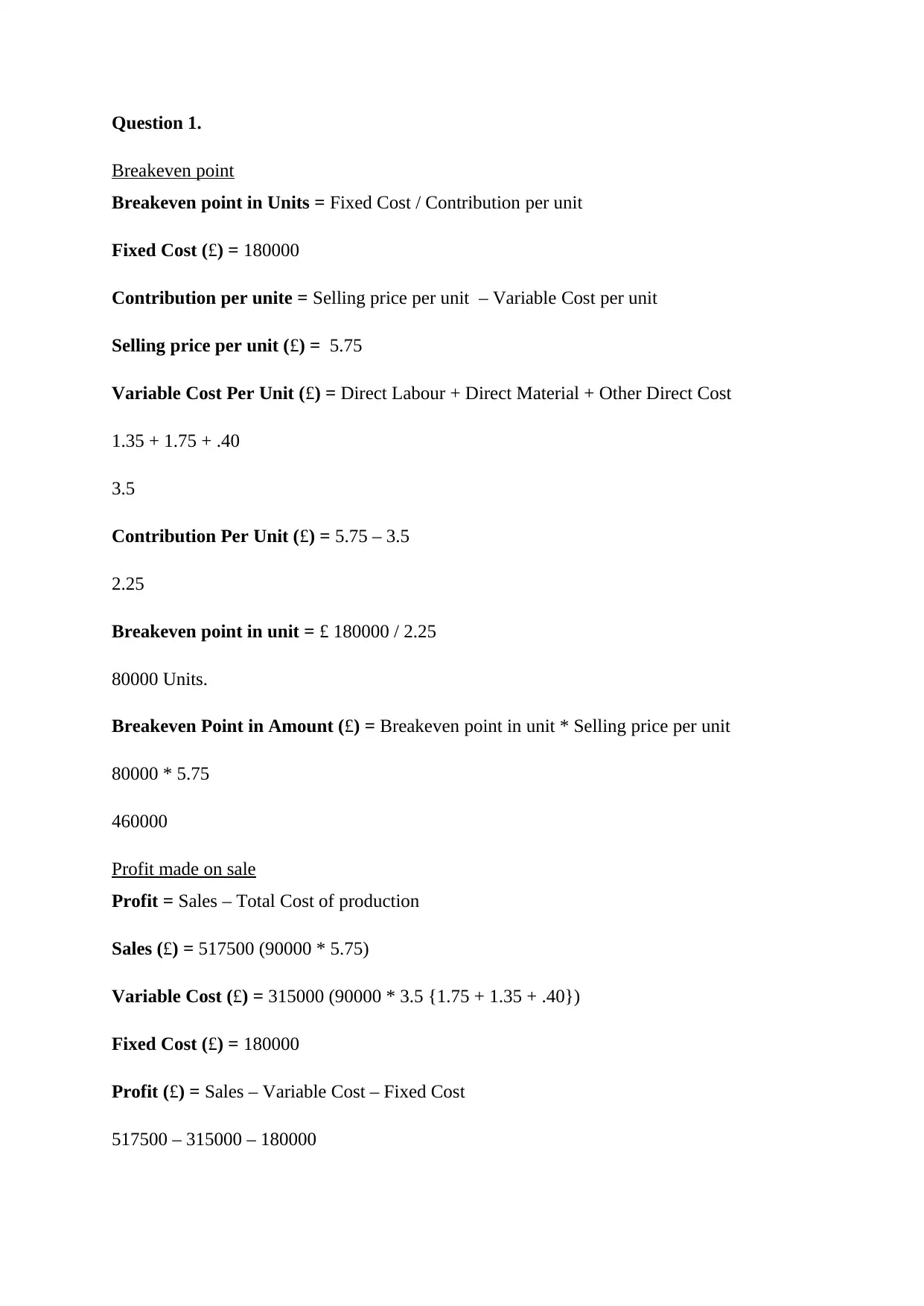
Question 1.
Breakeven point
Breakeven point in Units = Fixed Cost / Contribution per unit
Fixed Cost (£) = 180000
Contribution per unite = Selling price per unit – Variable Cost per unit
Selling price per unit (£) = 5.75
Variable Cost Per Unit (£) = Direct Labour + Direct Material + Other Direct Cost
1.35 + 1.75 + .40
3.5
Contribution Per Unit (£) = 5.75 – 3.5
2.25
Breakeven point in unit = £ 180000 / 2.25
80000 Units.
Breakeven Point in Amount (£) = Breakeven point in unit * Selling price per unit
80000 * 5.75
460000
Profit made on sale
Profit = Sales – Total Cost of production
Sales (£) = 517500 (90000 * 5.75)
Variable Cost (£) = 315000 (90000 * 3.5 {1.75 + 1.35 + .40})
Fixed Cost (£) = 180000
Profit (£) = Sales – Variable Cost – Fixed Cost
517500 – 315000 – 180000
Breakeven point
Breakeven point in Units = Fixed Cost / Contribution per unit
Fixed Cost (£) = 180000
Contribution per unite = Selling price per unit – Variable Cost per unit
Selling price per unit (£) = 5.75
Variable Cost Per Unit (£) = Direct Labour + Direct Material + Other Direct Cost
1.35 + 1.75 + .40
3.5
Contribution Per Unit (£) = 5.75 – 3.5
2.25
Breakeven point in unit = £ 180000 / 2.25
80000 Units.
Breakeven Point in Amount (£) = Breakeven point in unit * Selling price per unit
80000 * 5.75
460000
Profit made on sale
Profit = Sales – Total Cost of production
Sales (£) = 517500 (90000 * 5.75)
Variable Cost (£) = 315000 (90000 * 3.5 {1.75 + 1.35 + .40})
Fixed Cost (£) = 180000
Profit (£) = Sales – Variable Cost – Fixed Cost
517500 – 315000 – 180000
⊘ This is a preview!⊘
Do you want full access?
Subscribe today to unlock all pages.

Trusted by 1+ million students worldwide
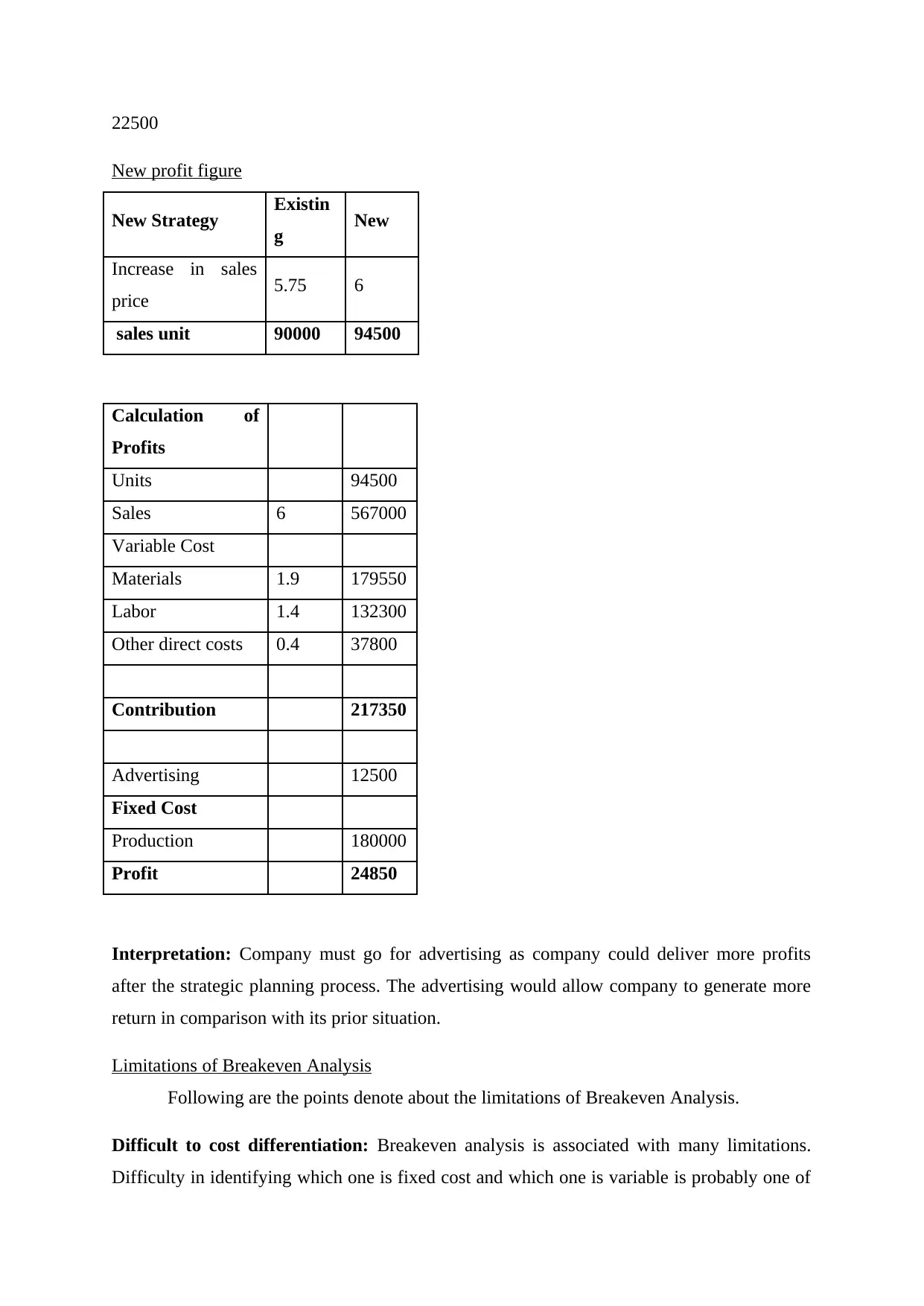
22500
New profit figure
New Strategy Existin
g New
Increase in sales
price 5.75 6
sales unit 90000 94500
Calculation of
Profits
Units 94500
Sales 6 567000
Variable Cost
Materials 1.9 179550
Labor 1.4 132300
Other direct costs 0.4 37800
Contribution 217350
Advertising 12500
Fixed Cost
Production 180000
Profit 24850
Interpretation: Company must go for advertising as company could deliver more profits
after the strategic planning process. The advertising would allow company to generate more
return in comparison with its prior situation.
Limitations of Breakeven Analysis
Following are the points denote about the limitations of Breakeven Analysis.
Difficult to cost differentiation: Breakeven analysis is associated with many limitations.
Difficulty in identifying which one is fixed cost and which one is variable is probably one of
New profit figure
New Strategy Existin
g New
Increase in sales
price 5.75 6
sales unit 90000 94500
Calculation of
Profits
Units 94500
Sales 6 567000
Variable Cost
Materials 1.9 179550
Labor 1.4 132300
Other direct costs 0.4 37800
Contribution 217350
Advertising 12500
Fixed Cost
Production 180000
Profit 24850
Interpretation: Company must go for advertising as company could deliver more profits
after the strategic planning process. The advertising would allow company to generate more
return in comparison with its prior situation.
Limitations of Breakeven Analysis
Following are the points denote about the limitations of Breakeven Analysis.
Difficult to cost differentiation: Breakeven analysis is associated with many limitations.
Difficulty in identifying which one is fixed cost and which one is variable is probably one of
Paraphrase This Document
Need a fresh take? Get an instant paraphrase of this document with our AI Paraphraser
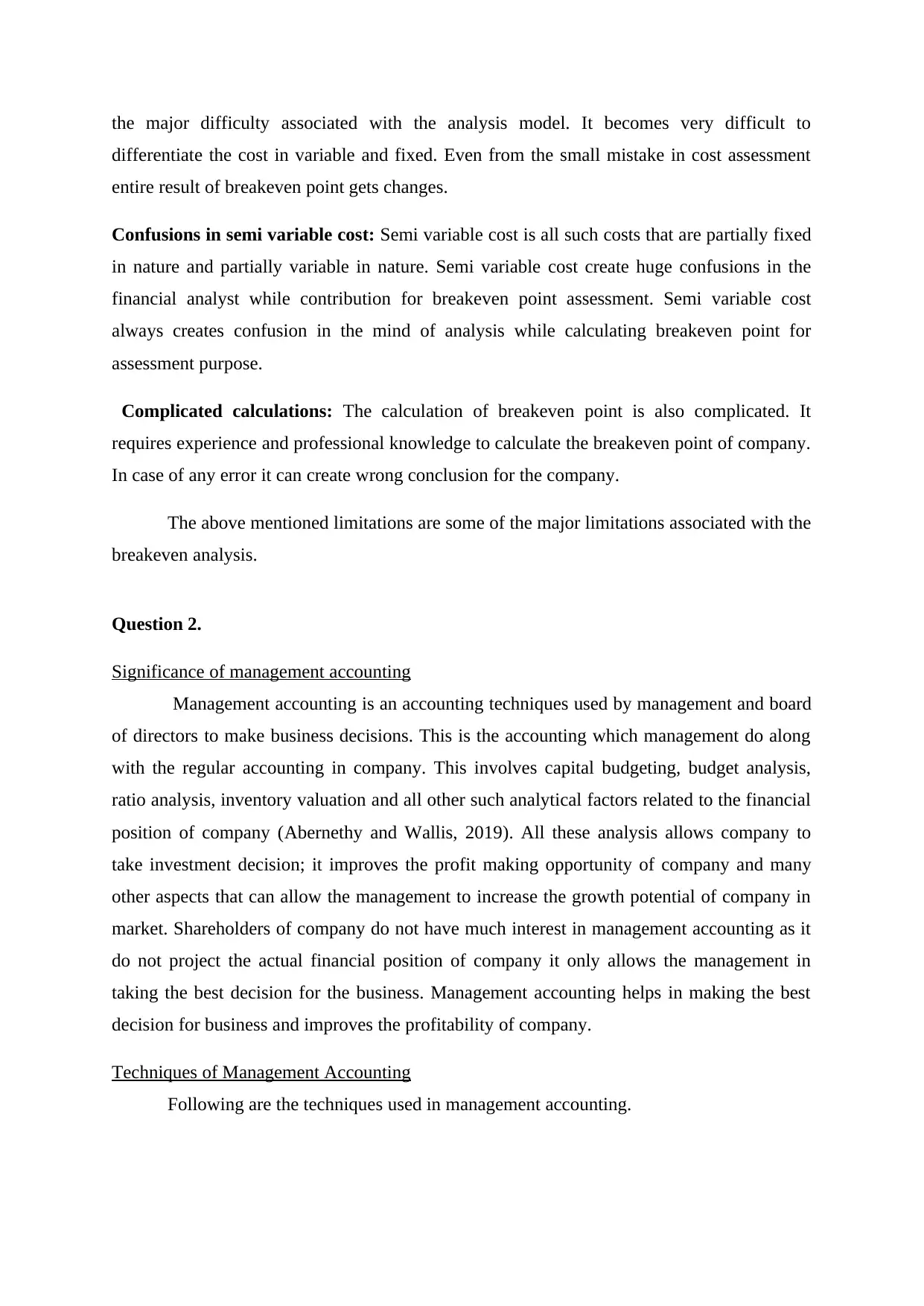
the major difficulty associated with the analysis model. It becomes very difficult to
differentiate the cost in variable and fixed. Even from the small mistake in cost assessment
entire result of breakeven point gets changes.
Confusions in semi variable cost: Semi variable cost is all such costs that are partially fixed
in nature and partially variable in nature. Semi variable cost create huge confusions in the
financial analyst while contribution for breakeven point assessment. Semi variable cost
always creates confusion in the mind of analysis while calculating breakeven point for
assessment purpose.
Complicated calculations: The calculation of breakeven point is also complicated. It
requires experience and professional knowledge to calculate the breakeven point of company.
In case of any error it can create wrong conclusion for the company.
The above mentioned limitations are some of the major limitations associated with the
breakeven analysis.
Question 2.
Significance of management accounting
Management accounting is an accounting techniques used by management and board
of directors to make business decisions. This is the accounting which management do along
with the regular accounting in company. This involves capital budgeting, budget analysis,
ratio analysis, inventory valuation and all other such analytical factors related to the financial
position of company (Abernethy and Wallis, 2019). All these analysis allows company to
take investment decision; it improves the profit making opportunity of company and many
other aspects that can allow the management to increase the growth potential of company in
market. Shareholders of company do not have much interest in management accounting as it
do not project the actual financial position of company it only allows the management in
taking the best decision for the business. Management accounting helps in making the best
decision for business and improves the profitability of company.
Techniques of Management Accounting
Following are the techniques used in management accounting.
differentiate the cost in variable and fixed. Even from the small mistake in cost assessment
entire result of breakeven point gets changes.
Confusions in semi variable cost: Semi variable cost is all such costs that are partially fixed
in nature and partially variable in nature. Semi variable cost create huge confusions in the
financial analyst while contribution for breakeven point assessment. Semi variable cost
always creates confusion in the mind of analysis while calculating breakeven point for
assessment purpose.
Complicated calculations: The calculation of breakeven point is also complicated. It
requires experience and professional knowledge to calculate the breakeven point of company.
In case of any error it can create wrong conclusion for the company.
The above mentioned limitations are some of the major limitations associated with the
breakeven analysis.
Question 2.
Significance of management accounting
Management accounting is an accounting techniques used by management and board
of directors to make business decisions. This is the accounting which management do along
with the regular accounting in company. This involves capital budgeting, budget analysis,
ratio analysis, inventory valuation and all other such analytical factors related to the financial
position of company (Abernethy and Wallis, 2019). All these analysis allows company to
take investment decision; it improves the profit making opportunity of company and many
other aspects that can allow the management to increase the growth potential of company in
market. Shareholders of company do not have much interest in management accounting as it
do not project the actual financial position of company it only allows the management in
taking the best decision for the business. Management accounting helps in making the best
decision for business and improves the profitability of company.
Techniques of Management Accounting
Following are the techniques used in management accounting.
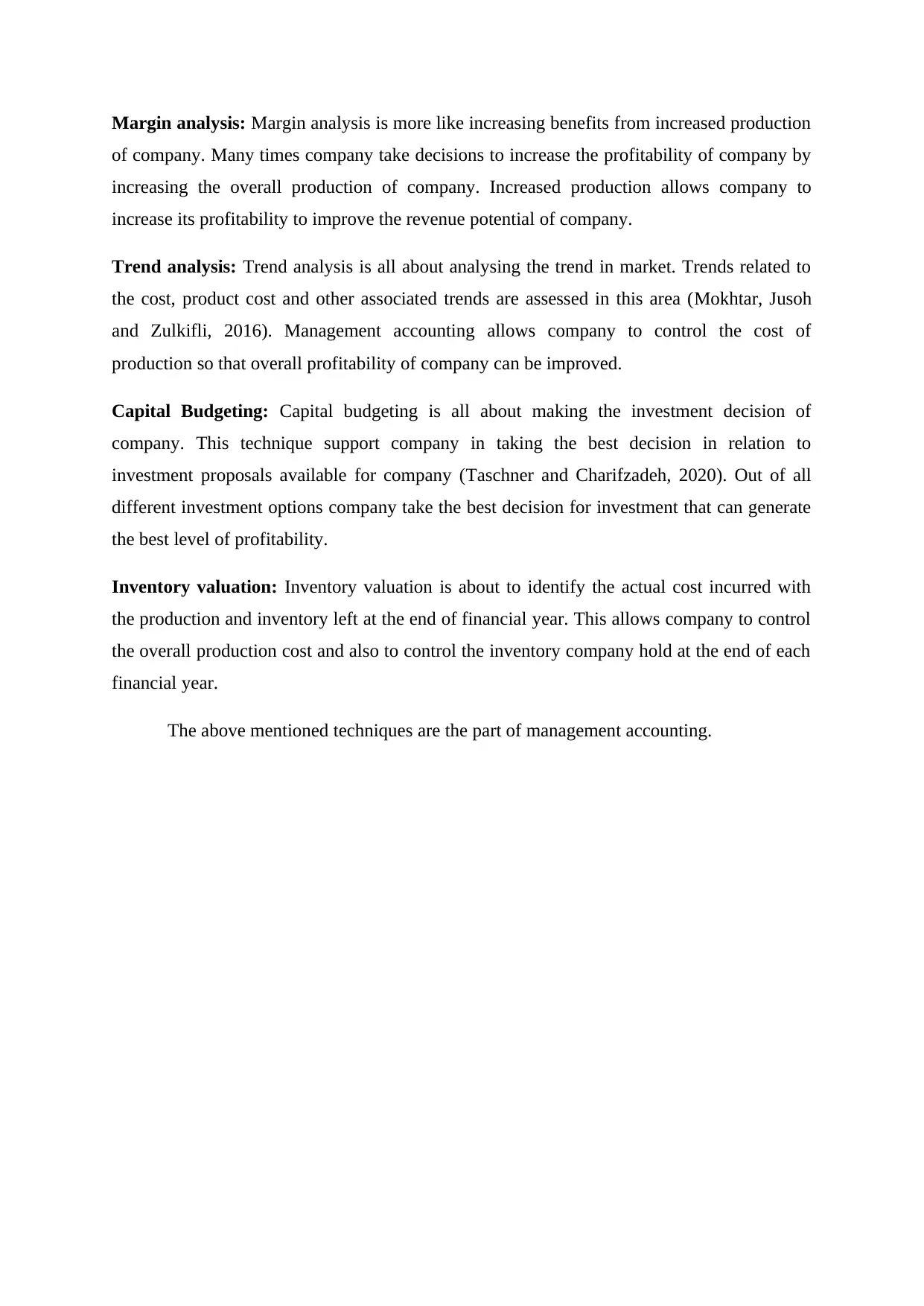
Margin analysis: Margin analysis is more like increasing benefits from increased production
of company. Many times company take decisions to increase the profitability of company by
increasing the overall production of company. Increased production allows company to
increase its profitability to improve the revenue potential of company.
Trend analysis: Trend analysis is all about analysing the trend in market. Trends related to
the cost, product cost and other associated trends are assessed in this area (Mokhtar, Jusoh
and Zulkifli, 2016). Management accounting allows company to control the cost of
production so that overall profitability of company can be improved.
Capital Budgeting: Capital budgeting is all about making the investment decision of
company. This technique support company in taking the best decision in relation to
investment proposals available for company (Taschner and Charifzadeh, 2020). Out of all
different investment options company take the best decision for investment that can generate
the best level of profitability.
Inventory valuation: Inventory valuation is about to identify the actual cost incurred with
the production and inventory left at the end of financial year. This allows company to control
the overall production cost and also to control the inventory company hold at the end of each
financial year.
The above mentioned techniques are the part of management accounting.
of company. Many times company take decisions to increase the profitability of company by
increasing the overall production of company. Increased production allows company to
increase its profitability to improve the revenue potential of company.
Trend analysis: Trend analysis is all about analysing the trend in market. Trends related to
the cost, product cost and other associated trends are assessed in this area (Mokhtar, Jusoh
and Zulkifli, 2016). Management accounting allows company to control the cost of
production so that overall profitability of company can be improved.
Capital Budgeting: Capital budgeting is all about making the investment decision of
company. This technique support company in taking the best decision in relation to
investment proposals available for company (Taschner and Charifzadeh, 2020). Out of all
different investment options company take the best decision for investment that can generate
the best level of profitability.
Inventory valuation: Inventory valuation is about to identify the actual cost incurred with
the production and inventory left at the end of financial year. This allows company to control
the overall production cost and also to control the inventory company hold at the end of each
financial year.
The above mentioned techniques are the part of management accounting.
⊘ This is a preview!⊘
Do you want full access?
Subscribe today to unlock all pages.

Trusted by 1+ million students worldwide
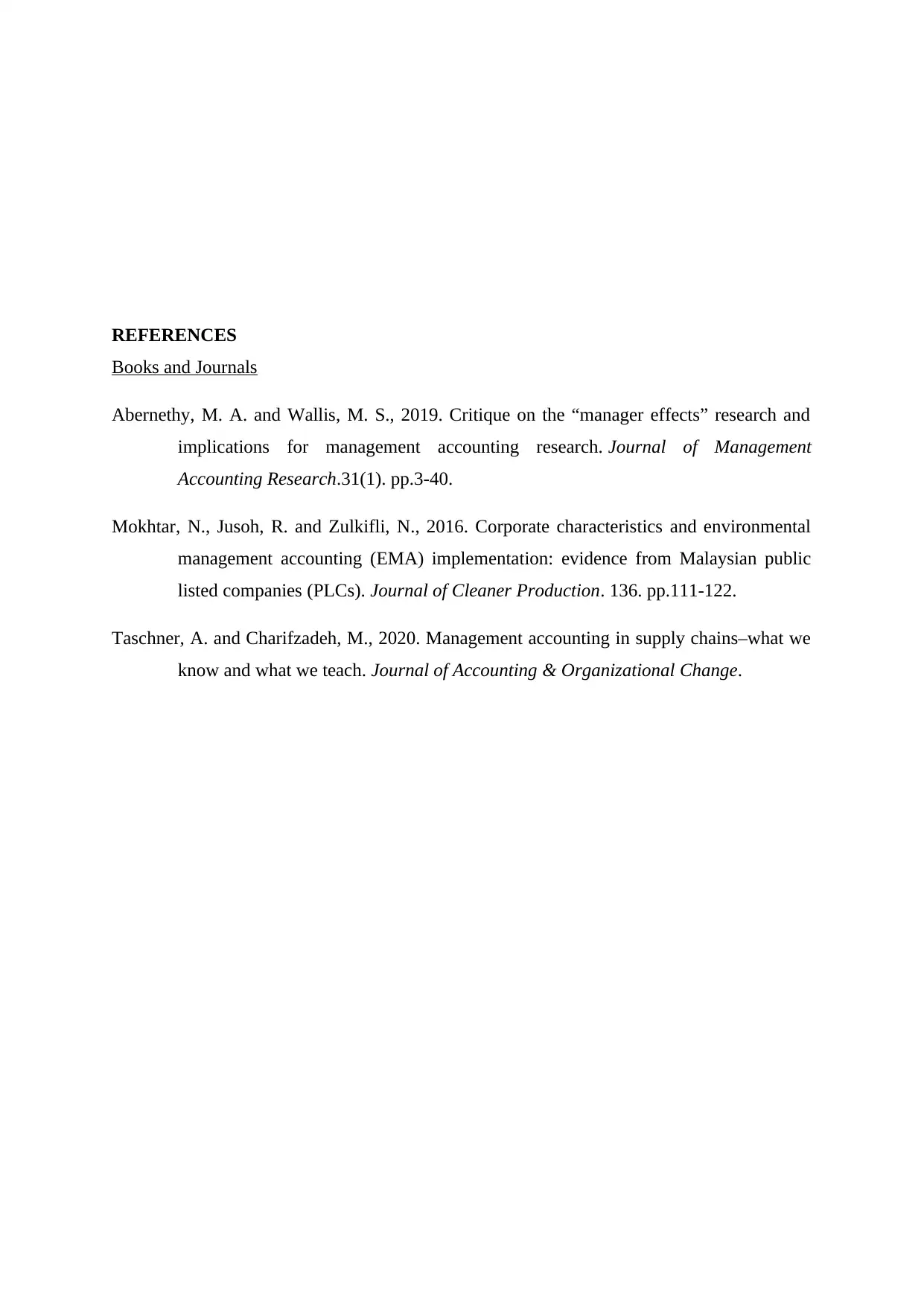
REFERENCES
Books and Journals
Abernethy, M. A. and Wallis, M. S., 2019. Critique on the “manager effects” research and
implications for management accounting research. Journal of Management
Accounting Research.31(1). pp.3-40.
Mokhtar, N., Jusoh, R. and Zulkifli, N., 2016. Corporate characteristics and environmental
management accounting (EMA) implementation: evidence from Malaysian public
listed companies (PLCs). Journal of Cleaner Production. 136. pp.111-122.
Taschner, A. and Charifzadeh, M., 2020. Management accounting in supply chains–what we
know and what we teach. Journal of Accounting & Organizational Change.
Books and Journals
Abernethy, M. A. and Wallis, M. S., 2019. Critique on the “manager effects” research and
implications for management accounting research. Journal of Management
Accounting Research.31(1). pp.3-40.
Mokhtar, N., Jusoh, R. and Zulkifli, N., 2016. Corporate characteristics and environmental
management accounting (EMA) implementation: evidence from Malaysian public
listed companies (PLCs). Journal of Cleaner Production. 136. pp.111-122.
Taschner, A. and Charifzadeh, M., 2020. Management accounting in supply chains–what we
know and what we teach. Journal of Accounting & Organizational Change.
1 out of 7
Related Documents
Your All-in-One AI-Powered Toolkit for Academic Success.
+13062052269
info@desklib.com
Available 24*7 on WhatsApp / Email
![[object Object]](/_next/static/media/star-bottom.7253800d.svg)
Unlock your academic potential
Copyright © 2020–2025 A2Z Services. All Rights Reserved. Developed and managed by ZUCOL.




